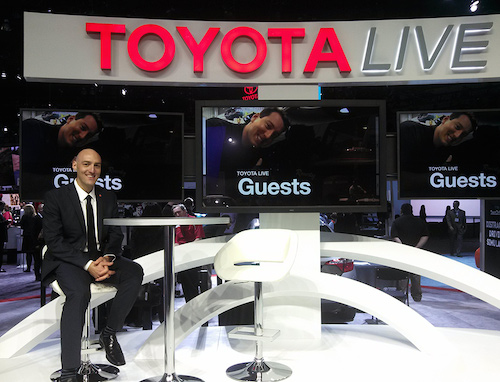
Stuart Fingerhut designs Scion’s presence at major international auto shows.
The following profile of Environmental Design alumnus Stuart Fingerhut appeared in the January 2015 issue of VSMD Magazine. Read how Fingerhut’s leading-edge thinking about reconceiving the retail experience to be more about connection than commerce informs the success of his experiential marketing work for Toyota’s Scion brand as well as his personal design practice creating functional art.
Stuart Fingerhut seems to have this experiential design thing all figured out. As creative director for Toyota’s Scion brand at the George P. Johnson Experience Marketing Agency in Los Angeles, Fingerhut is responsible for creating Scion’s presence at major international automobile shows.
The old idea of a booth with large advertising graphics and a car turning on a rotating platform with a bunch of attractive models has become about as relevant to the automotive industry as an AMC Gremlin.
“We create from the ground up,” says Fingerhut, “establishing a brand that resonates with the Scion buyer who says, ‘this brand, they get me.’”
To do that requires being steeped in all the 21st Century technology—social media, digital messaging and experiential design. The 29-year-old graduate of Art Center College of Design recognizes the power.
“It’s amazing what one-to-one marketing on social media can do for your message,” he says “exciting but also scary, because you can’t control it.”
On the side, Fingerhut has also used social media to develop a thriving studio, Stuart Fingerhut Design, where he creates eye-catching functionality in the spirit of his inspirations like Karim Rashid and Frank Gehry.
While an Art Center student, he designed a wall-mounted gun rack organizer (you have to see it), that went viral, leading to orders from all around the world.
One of his current specialty areas is pendant lighting for residential and commercial installations; it’s all available on his website.
“If you’ve done it right, soon everyone in the world is looking at it,” he says, and that phenomenon will soon rewrite the store design handbook.
“Too many brands still hold onto the old trope that a retail store is for selling,” says Fingerhut. “The store is still the physical hub. But it’s not just for selling stuff. It’s a 360 degree gathering place where you know other people like you are there or have been there or will be there. It’s a lifestyle experience where the audience connects and shares and has a good time. Then they buy stuff later—probably online.”








